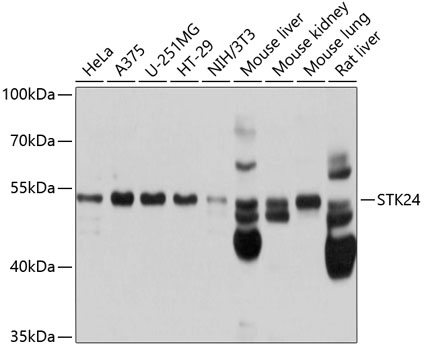-
Product Name
STK24 Polyclonal Antibody
- Documents
-
Description
Polyclonal antibody to STK24
-
Tested applications
WB, IHC, IF
-
Species reactivity
Human, Mouse, Rat
-
Alternative names
STK24 antibody; HEL-S-95 antibody; MST3 antibody; MST3B antibody; STE20 antibody; STK3 antibody; serine/threonine kinase 24 antibody
-
Isotype
Rabbit IgG
-
Preparation
Antigen: Recombinant fusion protein containing a sequence corresponding to amino acids 312-431 of human STK24 (NP_001027467.2).
-
Clonality
Polyclonal
-
Formulation
PBS with 0.02% sodium azide, 50% glycerol, pH7.3.
-
Storage instructions
Store at -20℃. Avoid freeze / thaw cycles.
-
Applications
WB 1:1000 - 1:2000
IHC 1:50 - 1:200
IF 1:50 - 1:200 -
Validations

Western blot - STK24 Polyclonal Antibody
Western blot analysis of extracts of various cell lines, using STK24 antibody at 1:1000 dilution.Secondary antibody: HRP Goat Anti-Rabbit IgG (H+L) at 1:10000 dilution.Lysates/proteins: 25ug per lane.Blocking buffer: 3% nonfat dry milk in TBST.Detection: ECL Basic Kit .Exposure time: 1s.
-
Background
Serine/threonine-protein kinase that acts on both serine and threonine residues and promotes apoptosis in response to stress stimuli and caspase activation. Mediates oxidative-stress-induced cell death by modulating phosphorylation of JNK1-JNK2 (MAPK8 and MAPK9), p38 (MAPK11, MAPK12, MAPK13 and MAPK14) during oxidative stress. Plays a role in a staurosporine-induced caspase-independent apoptotic pathway by regulating the nuclear translocation of AIFM1 and ENDOG and the DNase activity associated with ENDOG. Phosphorylates STK38L on 'Thr-442' and stimulates its kinase activity. In association with STK26 negatively regulates Golgi reorientation in polarized cell migration upon RHO activation. Regulates also cellular migration with alteration of PTPN12 activity and PXN phosphorylation: phosphorylates PTPN12 and inhibits its activity and may regulate PXN phosphorylation through PTPN12. May act as a key regulator of axon regeneration in the optic nerve and radial nerve.
Related Products / Services
Please note: All products are "FOR RESEARCH USE ONLY AND ARE NOT INTENDED FOR DIAGNOSTIC OR THERAPEUTIC USE"
